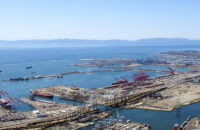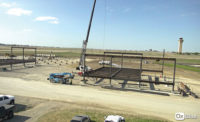The Port of Nome will offer the nation’s first Arctic deep-water port under an agreement between the U.S. Army Corps of Engineers Alaska District and the City of Nome, which owns and operates the port.
The $548-million project, with 90% paid for by the federal government and the remaining 10% by the city, will enable the port, also known as Nome Harbor, to handle more vessels at any given time and increase the depth of its harbor from 22 ft to 40 ft — sufficient to adequately accommodate a wide range of vessels for trade, tourism and national security.
Corps officials anticipate awarding a construction contract later this year.
“As sea ice recedes and shipping traffic increases in the Arctic, Nome finds itself at the center of an evolving world,” Col. Jeffrey Palazzini, Corps district commander, said in a statement. “A more efficient transportation hub in the form of this port expansion will create opportunities to improve housing, food security and infrastructure by reinforcing the region’s supply chain.”
The project partnership agreement signed on Jan. 25 is a key part of the federal process required to proceed. It describes the project and responsibilities of the federal government and the non-federal sponsor, which is the City of Nome, in the cost sharing and execution of work.
Joy Baker, City of Nome project manager, tells ENR the city expects the timeframe for the contract award sometime in late summer, pushing construction until spring 2025.
The main goal of the three-phase project will be to enlarge the outer basin of Nome Harbor while creating a new deep-water basin, the first in the Arctic for the United States. Dredging will deepen and maintain both the outer and deep-water basins and associated navigation channels.
Baker says Phase 1 is expected to take three to four seasons, dictated by contractor efficiencies, weather and material availability. Initial work will consist of mining rock. Full project completion is anticipated for 2030.
Serving as a regional hub centrally located on Alaska's western coast, the Port of Nome was created in 1917 on the Seward Peninsula, adjacent to Norton Sound. It is located 545 miles northwest of Anchorage and has no access to major Alaska road systems. Government officials believe that Nome, population 3,500, offers foundational importance to the viability of surrounding communities. The port also offers a launching point for vessels heading into the Bering Strait shipping lanes.
New construction at the port will extend the west causeway by more than 3,400 ft and create a new east causeway aligned with F Street, resulting in about 2,000 ft of useable dock moorage and a series of 400-ft docks attached to the causeways.
 Photo illustration courtesy US Army Corps of Engineers
Photo illustration courtesy US Army Corps of EngineersDepending on the size of the ships in the port, the expansion will double or triple the number of ships able to dock at one time. The 40-ft deep-water basin allows the port to accommodate large cruise ships, cargo vessels and every U.S. military ships smaller than an aircraft carrier.
The preconstruction, engineering, design phase and first phase of construction is now funded at $250 million, allowing for the project to move forward toward the awarding of a construction contract in 2024. The total project cost is $548 million. The recommended navigation improvement plan was first approved by the USACE in May 2020, then estimated at $491 million.
“The Port of Nome, the first deep-water port in the Arctic, will be positioned to play a critical role in ensuring the United States is a leader in the Arctic region in terms of national security, international trade and geopolitical influence,” Sen. Dan Sullivan (R-Alaska) said in a statement. “This announcement is a milestone for the project.”
Nome Mayor John Handeland says the U.S. has long needed a deep-water port to allow resupply and refueling services to the national security fleet operating in the Arctic. “The expanded port will enhance support in the transportation of critical goods and fuel throughout the region,” he adds.
The port upgrade is part of a U.S. national security focus on Alaska. The most recent defense bill signed by President Joe Biden in December included more than $200 million in funding for construction projects at Alaska military installations. One of the key projects receiving funding in the bill is the expansion of Joint Base Elmendorf-Richardson north of Anchorage to accommodate larger aircraft and more frequent use.
“The Alaska District’s current objectives in military construction are in line with larger goals around the agency,” says Valerie Palmer, acting chief of the district’s Programs and Project Management Division. “Quality-of-life improvements will continue to be a significant priority for the organization in 2024.”
Corps officials say they expect to award at least $125 million for civil works projects in Alaska this year. The district's portfolio of projects will be funded with nearly $1 billion for critical civil works and disaster relief projects in the coming decade.





Post a comment to this article
Report Abusive Comment